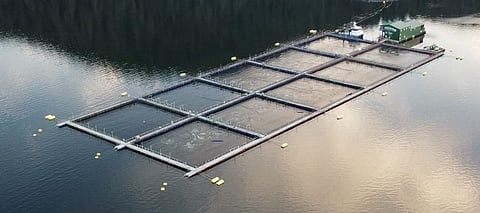

Recent claims by anti-salmon farming activists suggested that sea lice in juvenile wild salmon had declined by 96% between 2020 and 2022 in the Discovery Islands region of British Columbia due to the removal of salmon farms from the area. However, the BC Salmon Farmers Association (BCSFA) asserts that data collected by registered professional biologists does not support this claim. "The same narrative – this time shockingly slipping through the peer-review process – is recycled by anti-salmon farming campaigners annually," said Brian Kingzett, BCSFA Executive Director.
BC salmon producers have recalled that migrating juvenile wild salmon have been monitored annually by independent professional biological consultants in multiple BC salmon farming regions since 2017. During this time, no data has shown an increase in sea lice levels in wild salmon that have migrated beyond salmon farms in the Discovery Islands.
"Activists have changed sampling locations each year and selected just two data points to try and support their narrative while ignoring long-term trends from data collected all along the coast," stated Kingzett. "We now have seven years of independent sea lice monitoring demonstrating that sea lice levels have been consistently low with most out-migrating juvenile salmon while salmon farms were operating and after they were removed."
The BCSFA Executive Director explained that, in contrast, professional biologists have consistently measured sea lice abundance in wild juvenile salmon at the same locations for the past seven years in the Discovery Islands area. "The data shows that the sea lice abundance on juvenile wild salmon in 2022 was about 50% less than in 2020, however, that was the case both before they reached salmon farms and after they passed by salmon farms. Furthermore, 2022 sea lice levels were similar to 2017 and 2018 when all farms were active in the Discovery Islands region," he said.
This is not the first time that the BC Salmon Farmers Association remarks that the science backs them up against activists and that salmon farming has become a "convenient scapegoat for decline of wild salmon" in BC. In this new plea against anti-salmon farming activists, the BCSFA has recalled that there are several studies available to support their theories.
The Association itself published in 2021 a report on sea lice in response to the same claim made by anti-salmon farming activists. Similarly, a 2022 scientific response on sea lice from the Canadian Scientific Advisory Secretariat also concluded that there was no statistically significant association between sea lice on salmon farms and the likelihood of sea lice infestation of wild juvenile chum and pink salmon in Clayoquot Sound, Quatsino Sound, Discovery Islands, and the Broughton Archipelago.
But these are neither the only data nor the only sources. Although some Discovery Islands-related decisions such as the non-renewal of licenses go "against DFO's own science" – as Grieg Seafood BC claimed -, Canada's Department of Fisheries and Oceans (DFO) itself published an analysis (updated in August 2023) that, according to BCSFA, confirms that sea lice levels in Discovery Islands farmed salmon remained well below strict regulatory thresholds required during juvenile salmon runs.
The BC Salmon Producers Association members represent over 95% of the annual provincial harvest of farm-raised salmon in British Columbia. It includes more than 60 companies and organizations along the fish aquaculture value chain in the province. Farmed salmon is BC's highest-value fish product, BC's leading agricultural export, and generates over $1.2 billion for the province's economy, creating thousands of jobs.
